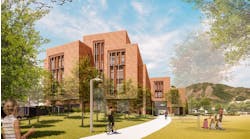The term “green schools” is a metaphor for the movement toward environmentally friendly education facilities. But when administrators and facility managers talk about green roofs, they mean it literally — roofs covered with plants and vegetation.
As the green movement gains momentum, more schools and universities are installing green roofs. Temple University has one growing atop the Intercollegiate Athletics Field House on its Ambler, Pa., campus; the Montgomery County (Md.) district has a green roof at Northwood High School in Silver Spring.
Green roofs come in two general categories, according to the U.S. Environmental Protection Agency. Intensive green roofs require at least a foot of soil depth to accommodate large trees and shrubs. This type of roof adds 80 to 150 pounds per square foot of load to a building structure. Extensive green roofs require 1 to 5 inches of soil depth and can accommodate many kinds of grasses and vegetative cover. These roofs add 12 to 50 pounds per square foot depending on soil characteristics and the type of substrate.
Among the benefits that green roofs provide: The vegetation acts as a sponge and absorbs rain that otherwise would end up as storm water runoff, the EPA says. The soil and plants that make up the green roof also filter pollution that may be contained in the rainwater.
The Low Impact Development Center, a non-profit organization based in Maryland, lists other ecological benefits that are associated with green roofs:
-
The layers of plants and vegetation conserve energy needed to heat and cool the building by providing insulation and reducing the “heat-island” effect. The layers also shield underlying roofing materials from the heat and rays of the sun, lengthening the life of a roof.
-
The green vegetation lessens air pollution by converting carbon dioxide to oxygen.
In addition, a green roof usually is more aesthetically appealing than a traditional roof. In some cases, a green roof can provide a habitat for birds or other small animals.
The EPA says the upfront cost of an extensive green roof in the United States starts at about $8 a square foot. That includes materials, preparation work and installation. The cost of a traditional built-up roof starts at about $1.25 per square foot, and cool roof membranes start at about $1.50 per square foot. The green roofs require more material and labor, and the number of green roofing contractors available is limited. The EPA predicts costs will decrease as more companies work on green roofs.
Intensive green roofs will need more attention than extensive roofs, but once a green roof is established, the Low Impact Development Center says, the maintenance required is minimal. Watering and fertilizing are needed until the plants and vegetation have established themselves.
A properly designed green roof will not need cutting, the center notes, but occasional weeding, especially as the roof plants are being established, may be necessary.
NOTABLE
8
In dollars per square foot, the estimated cost of installing a green roof in the United States.
Source: U.S. EPA
60 to 100
Percentage of storm water retained by a green roof.
Source: Michigan State University, Green Roof Research Program

